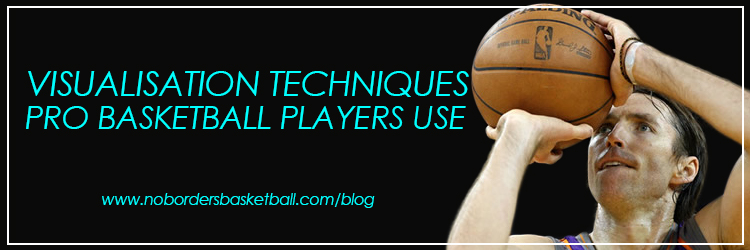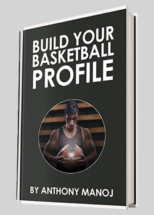Visualisation
I’m not sure if you have read many self-help books, maybe I’m making poor assumptions here. But I have actually read a fair few self-help books and even attended self-help seminars. One of the things these books and seminars have in common is teaching people visualisation techniques.
What is visualisation anyway?
Visualisation is focusing on something positive that you want in your life. It could be a new car, it could be to lose weight, it could be to make more money. It’s something that you aspire to obtain for which you visualise processing or attaining. Now there are negative visualisation but I don’t want to touch on that; that’s something that you want to try and avoid as it’s toxic to your mental state.
How does visualisation actually help basketball players?
Visualisation for basketball players is extremely important as it is with all athletes. In my article 5 psychological factors that influence your performance on the basketball court. I mention visualisation as one of the 5 most important techniques for an up and coming basketball player. I also go on to explain my experiences with Commonwealth athletes working with their sport psychologist and running visualisation sessions.
I have personally witnessed athletes while visualising the events they are going to compete for breaking out into a sweat. Yes, while sitting on a couch sweating as if they were taking part in the event. It blew me away when I first saw this!
When I was playing for the Solano Falcons (US community college) we had to regularly meet with our sport psychologist. One of the things that we often did during our visualisation session was to run through scenarios that happened in an average basketball game. For example, if we are two points down and I have the ball with 10 seconds to go. We play out a scenario and go through in my mind what I would do. What’s the purpose of that? What these scenario based sessions do is to prepare you mentally for situations if faced in a game. Playing a game that’s right down to the wire there is a certain amount of stress; in some cases due to the stress you can actually turn the ball over or make mistakes. By visualisation techniques you can go through a scenario in your mind and prepare for it. When you’re actually faced with that particular situation in reality you can make a decision with minimal pressure.
What the story is that I actually prefer to quite a bit on my blog is the fact that I made the Guildford heat basketball team in the first 15 minutes of 20 tryouts. I know what you’re saying we’ve had destroyed the format on but honestly it was a big thing for me to make the team. A few days prior to me going to my first trial with the Guildford heat I remember I used to sit on my bed every morning and every night and think about what I would be doing a tryouts how I will be playing dribbling the ball down the court controlling the ball Sydney at the teen making passes and getting everyone into the game. What do you think happen when we went to the truck training session? P much everything that I visualise came through it all materialised on the court soon as I got on there for lacing up my boots to the end when the coach came up and spoke to me and told me how pleased I was the was with my performance. Am I psychic? No I assure you I’m not. I just implemented a visualisation techniques which really really works so many times in my life when I have employed a visualisation techniques mostly by accident it’s always come true.
Don’t don’t believe me? Or let me give you another example. When I was in first year university at Monash (in Melbourne, Australia) I was on team that competed in the Monash lunchtime basketball competition. All the players on my team were playing representative basketball. Even our coaches were from representative clubs (representative clubs in Australia are pro and semi pro clubs). One of the players on my team had just finished playing high school basketball in America and at the time was playing in the Melbourne Metro League.
Our team looked like a shoo-in for the championship and and all the players on the team carried ourselves like we were going to walk over the competition and win the trophy. Yes we were cocky to put it simply. But we did lose one game! At the start of the season I kept bragging about our team going undefeated for the season. This type of attitude and the bragging didn’t win me many friends. In fact, a lot of people didn’t like my attitude. They thought I was arrogant and when we lost that one game, I copped it! They kept asking me, why did you lose the game? I thought you were saying that you were going to get through the season undefeated? Yea, I probably deserved that. But I believed in my team and the way we jelled and I honestly believe that no one in the competition had the chemistry we did.
Cocky or confidence? I guess it’s the way you see it. But the majority of the season panned out pretty much the way I actually visualised it. Thinking about winning the title; I remember thinking about holding the trophy. I remember thinking about how we were going to play as a team in the grand final. I remember thinking about doing the small things like playing hard d and getting every lose ball. But mostly I thought about how well we as a team were going to play in the grand final.
That season we won the championship despite everyone wanting us not to. It was clear that we were the most unpopular team. But, it was one of those moments when I look back that cemented how important visualisation is in the game of basketball. I visualised us winning the championship and it went to plan as if I was following a movie script. Right down to the award ceremony.
So how do you actually visualising basketball?
The easiest way to benefit from visualisation is to think about playing a basketball game. Think about the team you want to play for and you wearing the uniform. Focus on this before you go to bed and when you wake up in the morning.
An example of visualisaton. You want to play college basketball in America. But you’re currently playing domestic basketball or even on any team playing basketball. But you have a dream to go play college. Visualise every morning and at night, you actually playing for a college basketball team. Visualise playing a game for the team and playing your position.
This action tricks your brain into believing that you are an actual college player. This is tapping into your subconscious mind. Eventually through repetition and good work ethic on the court you will start to have the confidence to move that much closer to your goal.
Steps to visualising
- Make sure you are in a silent and comfortable place where you won’t get disturbed.
- Close your eyes and picture you playing in the situation you want to be reality. Eg college ball in U.S or pro ball in Europe, whatever it is.
- Picture in your mind training and playing the game. Most importantly picture yourself succeeding.
Eg. Hitting a game winning shot, making an amazing pass in traffic or hustling for a lose ball. - Do this every morning when you wake up and again just before you go to bed.
- What this process does is make you believing that you are already living your dream. The subconscious mind is a powerful thing. Using visualisation techniques you are able to trick the subconscious mind into believing in something worth working for, a goal.
Even if you’re very sceptical about this routine of visualisation I ask you to try this for 21 days. What have you got to lose? All you have to do is spend five minutes when you wake up and five minutes just before you go to bed, for 21 days.
Why 21 days? 21 days is the number of days necessary to build a habit. In this case a good habit. I am confident you will start to notice results almost immediately, especially in your game. You’ll be more confident and more focused. It worked for me!
So what are you visualising? I’d like you to think about what you want out of your basketball and come up with an image that you can project in your mind. I’d strongly encourage you to share what you will be visualising in the comments section below. It’s always good to share ideas with like minded people.

